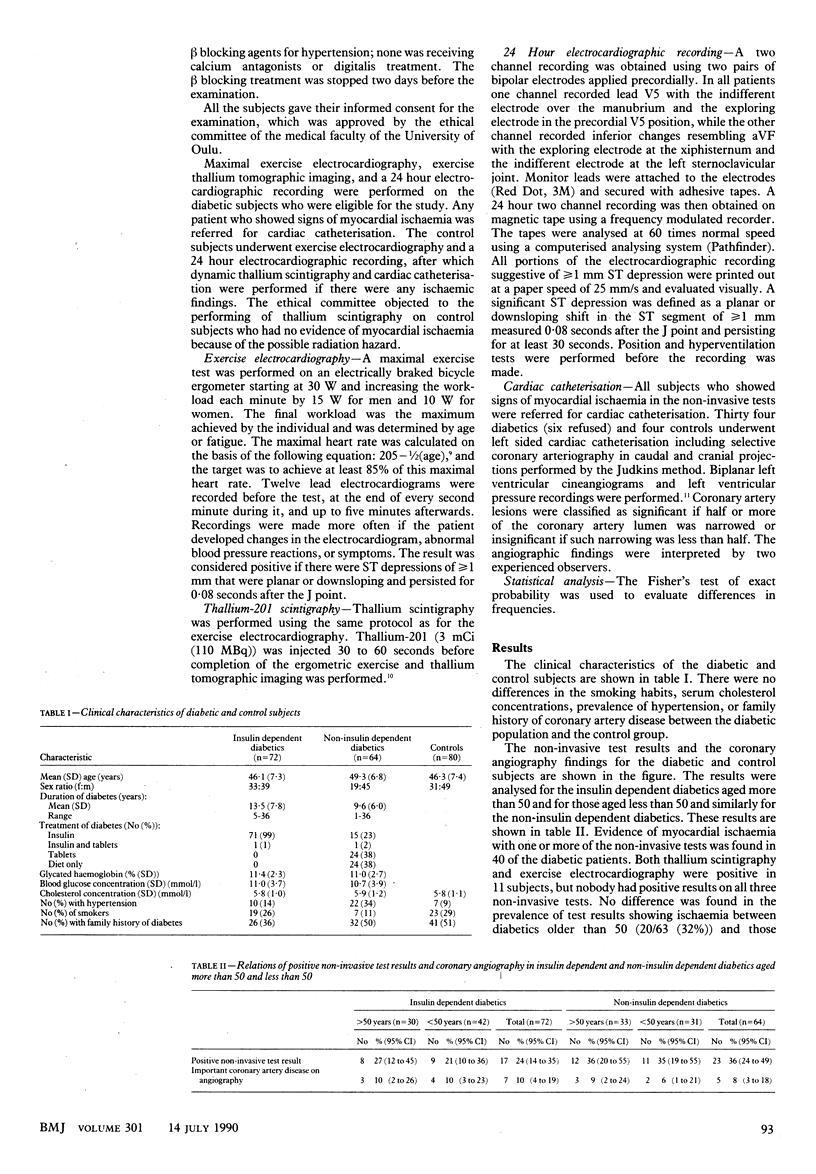Abstract
OBJECTIVE--To compare the prevalence of silent myocardial ischaemia associated with coronary artery disease in diabetic subjects with that in controls of similar age and sex. DESIGN--A controlled study in which subjects with positive findings on exercise electrocardiography, 24 hour electrocardiographic recording, or dynamic thallium scintigraphy (diabetics only) underwent coronary angiography. SETTING--Academic medical centre; referral based cardiology clinic. SUBJECTS--136 Diabetic subjects, of whom 72 (33 women, 39 men (mean age 46.0] were insulin dependent and 64 (19 women, 45 men (mean age 49.3] non-insulin dependent. 80 Controls matched for age and sex; all were clients of the Occupational Health Service of Oulu University Central Hospital or the State Occupational Health Service Station in Oulu in whom diabetes had been excluded by a glucose tolerance test. INTERVENTIONS--Any subject showing signs of myocardial ischaemia was referred for cardiac catheterization. MAIN OUTCOME MEASURES--Exercise electrocardiography and 24 hour electrocardiographic recording were regarded as positive if there were ST depressions of greater than or equal to 1 mm that were planar or downsloping and persisted for 0.08 seconds after the J point. Thallium tomographic imaging. With cardiac catheterisation, coronary artery lesions were classified as significant in half or more of the vessel lumen was narrowed, or insignificant if such narrowing was less than half. RESULTS--40 (29%) diabetes and four (5%) controls had positive results in one or more of the non-invasive tests. Coronary angiography was performed on 34 of the diabetics (six refused); 12 had significant coronary artery narrowing; seven had unimportant atherosclerosis; 15 had patent coronary arteries. Among the controls only one had unimportant atherosclerosis; the other three had patent arteries. CONCLUSIONS--These results confirm the high prevalence of asymptomatic myocardial ischaemia in diabetics. Non-invasive screening of diabetic subjects, however, does not seem justified because of the low preset probability of the presence of the disease and the inaccuracy of the available test methods.
Full text
PDF



Selected References
These references are in PubMed. This may not be the complete list of references from this article.
- Abenavoli T., Rubler S., Fisher V. J., Axelrod H. I., Zuckerman K. P. Exercise testing with myocardial scintigraphy in asymptomatic diabetic males. Circulation. 1981 Jan;63(1):54–64. doi: 10.1161/01.cir.63.1.54. [DOI] [PubMed] [Google Scholar]
- Assey M. E. Prognosis in stable angina pectoris and silent myocardial ischemia. Am J Cardiol. 1988 Apr 21;61(12):19F–21F. doi: 10.1016/0002-9149(88)90050-1. [DOI] [PubMed] [Google Scholar]
- BRADLEY R. F., SCHONFELD A. Diminished pain in diabetic patients with acute myocardial infarction. Geriatrics. 1962 May;17:322–326. [PubMed] [Google Scholar]
- Beller G. A., Gibson R. S. Sensitivity, specificity, and prognostic significance of noninvasive testing for occult or known coronary disease. Prog Cardiovasc Dis. 1987 Jan-Feb;29(4):241–270. doi: 10.1016/s0033-0620(87)80002-6. [DOI] [PubMed] [Google Scholar]
- Bellet S., Roman L. The exercise test in diabetic patients as studied by radioelectrocardiography. Circulation. 1967 Aug;36(2):245–254. doi: 10.1161/01.cir.36.2.245. [DOI] [PubMed] [Google Scholar]
- Chiariello M., Indolfi C., Cotecchia M. R., Sifola C., Romano M., Condorelli M. Asymptomatic transient ST changes during ambulatory ECG monitoring in diabetic patients. Am Heart J. 1985 Sep;110(3):529–534. doi: 10.1016/0002-8703(85)90070-5. [DOI] [PubMed] [Google Scholar]
- Froelicher V. F., Thompson A. J., Longo M. R., Jr, Triebwasser J. H., Lancaster M. C. Value of exercise testing for screening asymptomatic men for latent coronary artery disease. Prog Cardiovasc Dis. 1976 Jan-Feb;18(4):265–276. doi: 10.1016/0033-0620(76)90022-0. [DOI] [PubMed] [Google Scholar]
- Herman J. B., Medalie J. H., Goldbourt U. Differences in cardiovascular morbidity and mortality between previously known and newly diagnosed adult diabetics. Diabetologia. 1977 May;13(3):229–234. doi: 10.1007/BF01219704. [DOI] [PubMed] [Google Scholar]
- Huikuri H. V., Ikäheimo M. J., Linnaluoto M. M., Takkunen J. T. Left ventricular response to isometric exercise and its value in predicting the change in ventricular function after mitral valve replacement for mitral regurgitation. Am J Cardiol. 1983 Apr;51(7):1110–1115. doi: 10.1016/0002-9149(83)90354-5. [DOI] [PubMed] [Google Scholar]
- Huikuri H. V., Korhonen U. R., Airaksinen J., Ikäheimo M. J., Heikkilä J., Takkunen J. T. Comparison of dipyridamole-handgrip test and bicycle exercise test for thallium tomographic imaging. Am J Cardiol. 1988 Feb 1;61(4):264–268. doi: 10.1016/0002-9149(88)90928-9. [DOI] [PubMed] [Google Scholar]
- Kannel W. B., McGee D. L. Diabetes and cardiovascular disease. The Framingham study. JAMA. 1979 May 11;241(19):2035–2038. doi: 10.1001/jama.241.19.2035. [DOI] [PubMed] [Google Scholar]
- Kereiakes D. J., Naughton J. L., Brundage B., Schiller N. B. The heart in diabetes. West J Med. 1984 Apr;140(4):583–593. [PMC free article] [PubMed] [Google Scholar]
- Nesto R. W., Phillips R. T., Kett K. G., Hill T., Perper E., Young E., Leland O. S., Jr Angina and exertional myocardial ischemia in diabetic and nondiabetic patients: assessment by exercise thallium scintigraphy. Ann Intern Med. 1988 Feb;108(2):170–175. doi: 10.7326/0003-4819-108-2-170. [DOI] [PubMed] [Google Scholar]
- Pell S., D'Alonzo C. A. Factors associated with long-term survival of diabetics. JAMA. 1970 Dec 7;214(10):1833–1840. [PubMed] [Google Scholar]


